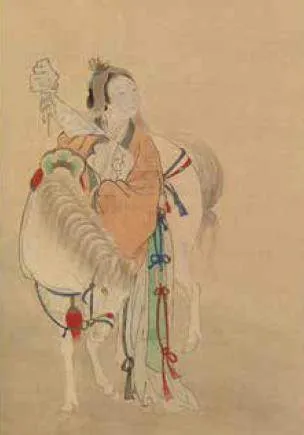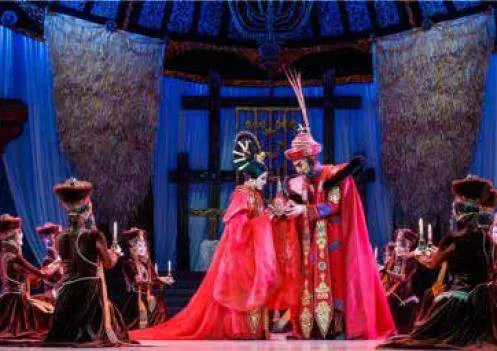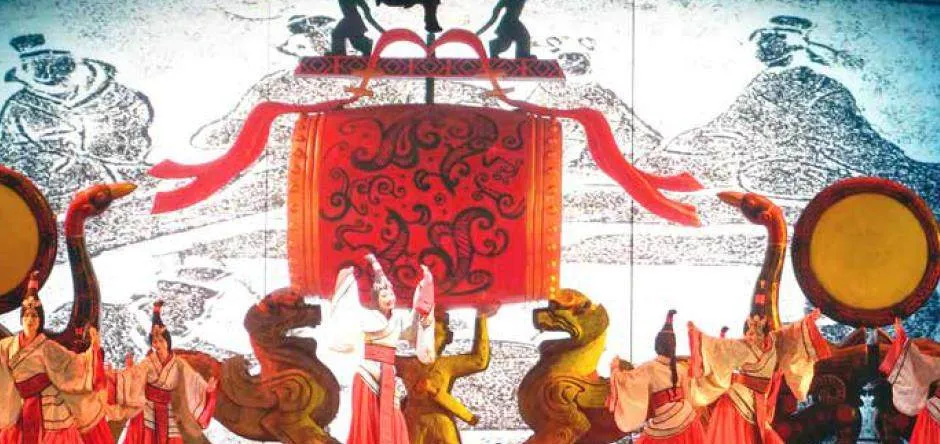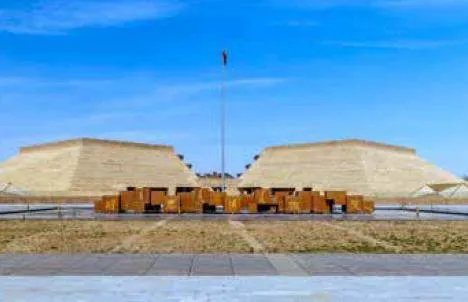最美和平之花
2024-01-01郭海燕




自古以来,内蒙古地区就是中国北方各民族繁衍生息的家园。秦汉相交时,匈奴冒顿单于(即匈奴最高首领)以内蒙古阴山地区为根据地,击败周围对手,建立了强大的游牧帝国。此时,中原的汉武帝雄才大略,麾下卫青、霍去病等名将辈出,威震匈奴,西汉进入鼎盛时期。后来,匈奴内乱丛生,最终分裂成南北二部。南匈奴呼韩邪单于和北匈奴郅支单于虽为同系兄弟,却生死相争。公元前54年,呼韩邪被郅支打败,他绝地求生,向汉朝称臣,以求庇护。在西汉的支持下,呼韩邪势力渐渐稳固。公元前33年,呼韩邪第三次抵长安朝见天子,表明自己愿做汉朝女婿,攀亲以求太平。真正持久的胜利就是和平啊!汉元帝龙颜大悦,将宫女王昭君赐呼韩邪单于为妻。
Since ancient times, the Inner Mongolia regionhas been a homeland for various ethnic groups innorthern China. During the transition from the Qinto the Han dynasties, the Xiongnu chieftain (chanyu)Modu established a powerful nomadic empire, usingthe Yinshan area of Inner Mongolia as his base todefeat surrounding rivals. At that time, Emperor Wuof the Han Dynasty, known for his exceptional talentand strategic vision, sent renowned generals like WeiQing and Huo Qubing to fight back the Xiongnu,and managed to lead the Western Han Dynasty to itszenith. However, internal strife within the Xiongnuled to its division into the northern and the southern factions. Despite being brothers of the same lineage,the Southern Xiongnu chieftain Huhanye and theNorthern Xiongnu chieftain Zhizhi found themselvesin a fierce rivalry. In 54 BC, after being defeated byZhizhi, Huhanye sought refuge by pledging allegianceto the Han Dynasty for protection. With the supportof the Western Han, Huhanye gradually stabilized hispower. In 33 BC, he made his third visit to Chang’anto pay homage to the emperor, expressing his desireto become the emperor’s son-in-law so as to promotepeace. Emperor Yuan of Han was delighted: True andlasting victory lies in peace! He then granted WangZhaojun, a palace lady, to Huhanye as his wife.
华夏历史上,和亲是两个不同民族政权上层间的联姻,中国文献里有明确记载的和亲次数至少有360 次。不可否认,和亲在缓和关系、减少战争以及加强交流、促进民族交融等方面发挥了重要作用。
In Chinese history, heqin (peaceful marriagealliances) represented a form of marriage betweenthe upper echelons of different ethnic regimes, withat least 360 instances recorded in literature. Thesealliances significantly contributed to easing tensions,reducing warfare, and enhancing exchanges, therebyfacilitating the integration of various ethnic groups.
告别故土、越过重重边关的王昭君心里清楚,此去万里,再难归返。从小生长于三峡美丽的青山绿水间、怀抱琵琶远嫁的佳人,北行路上唯见黄沙滚滚、雁鸣马嘶,她心绪难平,便弹奏了一曲《琵琶怨》。眉目如画的美人、幽怨婉转的琴声打动了天上的大雁,它们纷纷飞落四周,凝神聆听……。据传说,成语“平沙落雁”便由此而来。这一幕也成就了“昭君出塞”的美丽传说。
As Wang Zhaojun bid farewell to her homelandand crossed numerous border passes, she came torealize that she would never return. Surroundedby the lush green mountains and clear waters ofthe Three Gorges, Zhaojun, clutching her pipa,envisioned nothing but rolling sands, migratinggeese, and neighing horses on her northward journey.Overwhelmed by emotion, she played a piece titled“The Pipa’s Lament.” Legend has it that her delicatefeatures and the melancholic, graceful sound ofher playing captivated the flying geese overhead,causing them to descend and listen intently. Thispoignant scene is the origin of the Chinese idiom pingsha-luoyan (wild geese landing on the sand), anexpression often used to describe peace and nature,and a snapshot of the beautiful story of Zhaojunchusai(Zhaojun going beyond the border).
王昭君以汉朝公主身份出嫁,仪仗丰隆,陪嫁的中原书籍、工匠、农作物种子等,马拉车载,盛况空前。抱得美人归的呼韩邪单于在西汉的支持下重新统一了匈奴。昭君同单于感情弥深,她亲授塞外女子纺织技艺,传播汉文化和中原音乐,促进了中原农耕文明与草原游牧文化的交流融合。北疆人民也由此接触到各种先进的中原技艺,生活和生产水平得以提升。此外,昭君不忘和平使命,她劝勉匈奴王减少战争,致力于社会经济大发展,从而开创了北疆一带“牛马布野、人民炽盛”的盛景,汉匈之间结束了20年的战争,开启了近60年的和平局面。
Zhaojun married as a Han Dynasty princesswith a grand entourage, accompanied by a wealthof books, many craftsmen, and seeds for crops, allcarried by horse-drawn carriages in an unprecedentedspectacle. With the support of the Western Han,Huhanye, now her husband, successfully reunifiedthe Xiongnu. The affection between Zhaojun andHuhanye deepened, and she personally taught thewomen beyond the frontier the art of weaving, andspread Han culture and Central Plains music on thegrasslands. Her effort promoted the integration ofthe agricultural civilization of the Central Plains withthe nomadic culture of the grasslands, allowing the northern frontier’s people to gainaccess to advanced techniquesfrom the Central Plains, andeventually improve their livingstandards and productionmethods. Furthermore, Zhaojun,mindful of her mission forpeace, encouraged the Xiongnuking to minimize warfare andfocus on societal and economicdevelopment, thus creating aprosperous scene in the northernfrontier where “cattle and horsesroamed the fields, and the peoplethrived.” All this marked the endof 20 years of conflict betweenthe Han and the Xiongnu,ushering in nearly 60 years ofpeaceful relations.
从古至今,人们始终尊崇这位最美和平使者。古时,百姓感恩昭君带来了和平与美好的生活,诗人、文人则纷纷挥洒笔墨表达赞美之情。时至当代,仍有大量的研究对昭君出塞的历史意义进行探讨。21世纪初,长期从事古代文学文化研究的学者蒋方教授认为,王昭君作为文化符号,其内涵丰富多彩:她是不同文化相交相融的代表,是民族和睦友好的使者,还是和平外交的典范。此外,她还在中国古代的男权社会中脱颖而出,因卓越的功绩被载入史册。史学大师翦伯赞也说:“在大青山脚下,只有一个古迹是永远不会废弃的,那就是被称为青冢的昭君墓。因为在内蒙人民的心中,王昭君已经不是一个人物,而是一个象征,一个民族友好的象征。”
From ancient times to thepresent, people have alwaysrevered Zhaojun as a messengerof peace. For generations, thecommon folk expressed theirgratitude for the peace andimproved lives she brought,while poets and scholarsadmired her through theirwritings. Even today, extensiveresearch continues to explorethe historical significance ofher journey beyond the border.At the beginning of the 21stcentury, Professor Jiang Fang, ascholar of ancient literature andculture, noted that Zhaojun, as acultural symbol, embodies richconnotations: she representsthe intersection and integration of different cultures,serves as an envoy of ethnic harmony, and standsas a model of peaceful diplomacy. Furthermore,against the backdrop of the patriarchal society ofancient China, she managed to carve out a niche forherself in history with her remarkable achievements.The esteemed historian Jian Bozan also stated, “Atthe foot of the Daqing Mountains, there is onehistorical site that will never be forgotten: the tombof Zhaojun, known as Qingzhong. This is because inthe hearts of the people of Inner Mongolia, Zhaojuntranscends her individuality and is a symbol of ethnicfriendship.”
王昭君是西汉时期南郡秭归人,即今湖北宜昌市兴山县人。因为她,内蒙古与湖北结下了千年不解之缘。1987年初秋,由内蒙古呼和浩特市推出的大型歌舞剧《塞上昭君》进京献演,该剧的编演获得湖北省政府和武汉市政府的大力支持。蒙鄂两地艺术精英的携手使演出大获成功,反响热烈。不久,该剧回昭君故乡“探亲”,在武汉演出时再次火爆全城。30年后的2017年夏,湖北与内蒙古两地组织昭君文化主题旅游,宜昌首开“昭君专列”,满载近800名游客重走“和亲路”。他们携1 000份昭君故乡水土抵达塞北,汇入缅怀昭君的祭坛。作为多年友好区县,湖北的兴山县和内蒙古的玉泉区还签署协议,共同打造区域旅游整体形象和昭君品牌。
Zhaojun was from Zigui County under NanjunPrefecture during the Western Han Dynasty, presentdayXingshan County in Yichang City, HubeiProvince. Because of her, Inner Mongolia and Hubeihave forged a bond that has lasted for over a thousandyears. In early autumn of 1987, the large-scale songand dance drama Princess Zhaojun, produced inHohhot, Inner Mongolia, was performed in Beijingfor the first time, receiving robust support from thegovernments of Hubei Province and Wuhan City.The collaboration between artistic elites from bothregions led to great success, garnering an enthusiasticresponse. Shortly thereafter, as the production wentto Wuhan, captivating the city instantly, Zhaojunfinally “returned to her hometown.” Thirty years later,in the summer of 2017, thanks to the joint effort ofHubei and Inner Mongolia governments, the firstZhaojun cultural theme tour came into being, and the“Zhaojun Special Train” was launched from Yichang.This train carried nearly 800 tourists retracing the“heqin path,” bringing along 1,000 portions of soiland water from Zhaojun’s hometown to be offered atthe altar commemorating her. As long-standing sisterregions, Xingshan County in Hubei and YuquanDistrict in Inner Mongolia signed an agreement tojointly promote regional tourism and the Zhaojunbrand.
2 000多年来,王昭君,这位最美和平使者的目光,如朝阳,如春风,缱(qiǎn)绻不已,历久弥新。昭君故事不但在中华大地上家喻户晓,在日本、韩国等国家也广为人知,近年来更是不断吸引着全球的目光。昭君文化作为诚信文化的见证,作为“美”文化、“和”文化的典范,犹如一朵象征纯洁和平的百合花,散发着温柔的馨香。
For more than 2,000 years, Wang Zhaojun, themost beautiful envoy of peace, has looked upon theworld with eyes reminiscent of the rising sun andthe gentle touch of spring breezes, leaving a lastingimpression that feels both timeless and refreshing.Her story is not only a cherished tale across Chinabut also resonates deeply in neighboring countrieslike Japan and Republic of Korea, increasinglycapturing the global imagination in recent years.Zhaojun, as a testament to integrity, embodies idealsof beauty and harmony, and she stands like a delicatelily, a symbol of pure peace, exuding a soft fragrancethat enchants all who encounter it.
